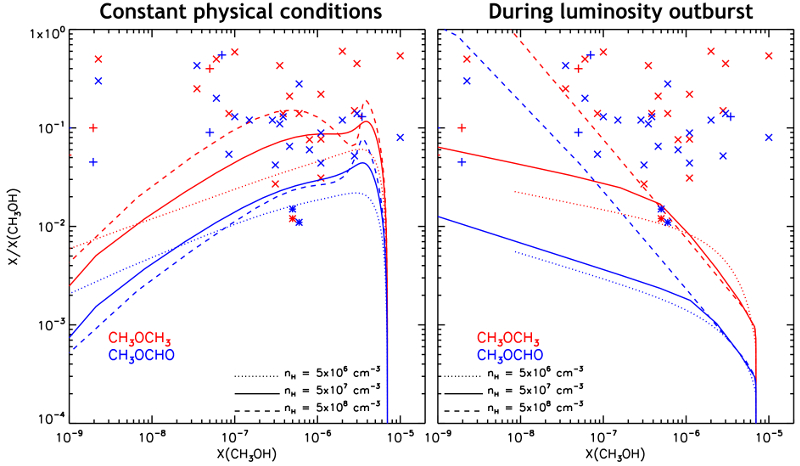| EPoS Contribution |
|
Formation and recondensation of complex organic molecules during protostellar luminosity outbursts
Vianney Taquet Leiden Obs, Leiden, NL | |
| During the formation of stars, the accretion of the surrounding material towards the central object is thought to undergo strong luminosity outbursts, followed by long periods of relative quiescence, even at the early stages of star formation when the protostar is still embedded in a large envelope. We investigated the gas phase formation and the recondensation of several oxygen-bearing complex organic molecules induced by sudden ice evaporation processes occurring during luminosity outbursts of different amplitudes in protostellar envelopes. For this purpose, we updated a gas phase chemical network forming complex organic molecules in which ammonia plays a key role.The model calculations presented here demonstrate that ion- molecule reactions alone can account for the observed presence of the two prototype molecules di-methyl ether and methyl formate in a large fraction of protostellar cores, without recourse to grain-surface chemistry. In spite of the short outburst timescales of about one hundred years, abundance ratios of the considered species with respect to methanol higher than 10% are predicted during outbursts due to their low binding energies relative to water and methanol that delay their recondensation during the cooling. Although the current luminosity of most embedded protostars would be too low to produce complex organics in hot core regions that can be observable with current sub-millimetric interferometers, previous luminosity outburst events would induce a formation of COMs in extended regions of protostellar envelopes with sizes increasing by up to one order of magnitude. | |
 | |
| Caption: Evolution of the gaseous abundances of di-methyl ether CH3OCH3 and methyl formate CH3OCHO relative to methanol with the absolute methanol abundance predicted with our gas phase chemical network for constant physical conditions typical of hot cores (left) and during a typical protostellar luminosity outburst for three different densities. Pluses, stars, and crosses represent the ratios observed towards low-mass, intermediate-mass, and high-mass protostars, respectively, summarised in Taquet et al. (2015). It can be seen that physical conditions strongly impact the abundances of these molecules, and abundances observed towards a significant fraction of protostars can be reproduced with our gas phase chemical network. | |
| Collaborators: E.S. Wirstrom, OSO, SW S.B. Charnley, NASA GSFC, US |
Suggested Session:
Chemistry |

